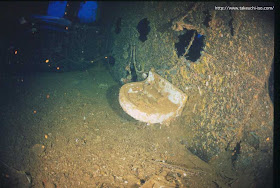El destino del crucero auxiliar
Aikoku Maru
El Aikoku Maru fue construido como transatlántico mixto de 10.348 toneladas y botado el 31 de agosto de 1941 se transformó en crucero auxiliar con el estallido de la guerra. El buque recibió 8 cañones antiaéreos de 140 mm, 2 de 76´2 mm, 4 ametralladoras de 25,5 mm, 2 ametralladoras de 13,5 mm y dos montajes dobles de tubos lanzatorpedos. También se le equipó con dos hidroaviones de reconocimiento Kawanishi E7K. El 15 de octubre de 1941 el Aikoku Maru junto con sus buques hermanos, Hokoku Maru y Gokoku Maru, fueron asignados a la división de cruceros auxiliares Nº 24.
Estos buques se dedican a interceptar buques mercantes hundiendo al SS Vicente (13 de diciembre de 1941) y al SS Malama (2 de enero de 1942). Desde febrero hasta junio de 1942, actúa como abastecedor de submarinos en alta mar y el 12 de julio de ese año, operando con su buque gemelo, Hokoku Maru, apresan al buque cisterna neozelandés SS Hairaka que es llevado a puerto con una dotación de presa. Este buque compartiría un par de años más tarde la suerte de su atacante.
Desde 1943 el Aikoku Maru desarrolla labores de transporte de tropas en el Pacífico. El 10 de julio de ese mismo año sufre el ataque de un avión del USS Halibut que le causa 21 bajas y algunos daños. El 16 de febrero de 1944 alcanza el arrecife de Truk cargado de tropas desde Ponapé sin saber que la inmensa flota Task Force 58 se encuentra preparada para atacar las posiciones japonesas en el arrecife.
Aikoku Maru 1941
Al día siguiente comienza el ataque norteamericano sobre Truk en la denominada operación Hailstorm. En ese momento la 1º Brigada Anfibia se encontraba a bordo del Aikoku Maru. Durante los primeros compases del ataque un certero impacto de un Grumman Avenger alcanza la cubierta del transatlántico provocando un incendio que se propaga con rapidez. Un segundo aparato del mismo tipo se lanza sobre el buque logrando un impacto sobre el cargamento de municiones estallando en una gran bola de fuego. La explosión fue de tal magnitud que el Avenger resultó destruido también devorado por las llamas.
La gran explosión desintegró una mitad del navío mientras que la otra era engullida por el mar rápidamente. Nadie de los que se encontraban a bordo logró sobrevivir a esta explosión y su capitán Nakamaruo, tripulación y muchos de sus pasajeros yacen en el arrecife de Truk junto con los restos del Aikoku Maru. En el 2008 se procedió a la repatriación de cuerpos de este naufragio.
Instante de la explosión del Aikoku Maru
Fuentes:
BALLEY, D. “World War II Wercks of the Truk Lagoon” North Valley, 2001
STEVART, W. “Ghost Fleet of the Truk Lagoon: An Account of "Operation Hailstone", February” Pictorial Histories Pub Co, 1986
LINDEMAN, K. “Hailstorm Over Truk Lagoon: Operations Against Truk by Carrier Task Force 58, 17 and 18 February 1944, and the Shipwrecks of World War II” Resource Publications, 2005
English version
The Aikoku Maru was built as a transatlantic joint 10,348 tons and launched on August 31, 1941 became an auxiliary cruiser with the outbreak of war. The ship received 8 AA guns 140 mm, 2 of 76.2 mm, 4 machine guns 25.5 mm, 2 machine guns 13.5 mm and two twin torpedo tubes mounts. It is also equipped with two Kawanishi reconnaissance seaplanes E7K. On 15 October 1941 Aikoku Maru with its sister ships, Gokoku Maru and Hokoku Maru, and were assigned to the division of auxiliary cruisers No. 24.
These vessels are engaged in sinking merchant ships to intercept SS Vincent (December 13, 1941) and the SS Malama (January 2, 1942). From February to June 1942, acting as a supplier of submarines at sea and on 12 July of that year, working with its sister ship, Hokoku Maru, apprehend the tanker SS Hairaka Zealander who is led to port with a budget of prey . This ship would share a couple of years later the fate of his attacker.
Since 1943 the work develops Aikoku Maru transporting troops in the Pacific. On July 10 of that year is attacked by an aircraft of the USS Halibut that causes 21 casualties and some damage. On February 16, 1944 reaches the reef full of troops from Ponape to Truk unaware that the vast fleet Task Force 58 is ready to attack Japanese positions on the reef.
The next day begins the American attack on Truk in the operation called Hailstorm. At that time the 1st Amphibious Brigade was on board the Aikoku Maru. During the early stages of attack a certain impact of a Grumman Avenger reaches the deck of the liner causing a fire that spreads rapidly. A second unit of the same type is cast on the ship making an impact on the shipment of ammunition exploding in a fireball. The explosion was so great that the Avenger was destroyed also devoured by the flames.
The great explosion disintegrated half of the ship while the other was quickly swallowed by the sea. None of those who were on board managed to survive the explosion and Nakamaruo captain, crew and many passengers lying on the reef of Truk along with the remains of Aikoku Maru. In 2008 he proceeded to the repatriation of remains of this shipwreck.
Sources:
BALLEY, D. “World War II Wercks of the Truk Lagoon” North Valley, 2001
STEVART, W. “Ghost Fleet of the Truk Lagoon: An Account of "Operation Hailstone", February” Pictorial Histories Pub Co, 1986
LINDEMAN, K. “Hailstorm Over Truk Lagoon: Operations Against Truk by Carrier Task Force 58, 17 and 18 February 1944, and the Shipwrecks of World War II” Resource Publications, 2005






No hay comentarios:
Publicar un comentario